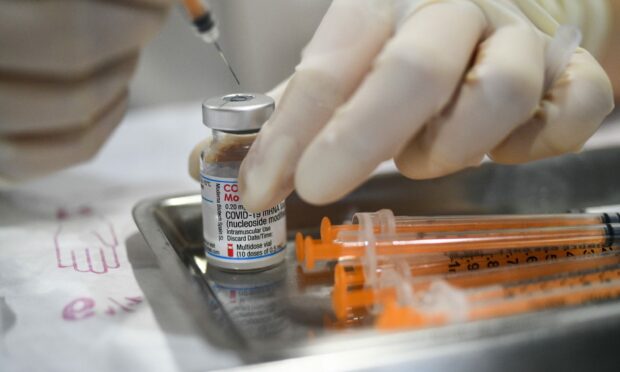As it has been announced all adults in Scotland are to be offered a booster jab before the end of the year – we’ve looked at how the vaccination rollout is progressing across Aberdeen, Aberdeenshire, Moray and the Highlands.
In Scotland, as of December 12, 4,362,468 people had received a first dose of the Covid-19 vaccination, 3,973,761 had received a second, and 2,116,228 had received either a booster shot, or a third dose vaccination.
This works out as 79.85% of the population having received a first dose, and 72.74% receiving a second dose.
On average, more than 30,000 booster shots are being delivered a day.
How many people have received their second dose and booster vaccines?
The below chart shows the percentage of adults in Scotland who have had second doses, and a third or booster dose of the vaccine as of December 9, broken down by age.
As of December 9, 45.88% of adults over 18 have had a third dose or booster vaccine.
To be eligible for a booster jab, you have to have had a second dose of the vaccine more than three months ago.
First Minister Nicola Sturgeon said in a statement on Sunday, December 12, that the covid vaccination booster would be offered to all adults in Scotland by New Year.
It comes following concerns over the Omicron variant’s transmissibility, which is anticipated to take over from Delta as the dominant strain of the virus.
It is hoped that all eligible adults will have had a booster jab by the end of January, however Boris Johnson indicated in a speech on Sunday night that he was hoping all adults who are able to, will have gotten the booster by the end of December.
The chart below shows the two dates, and how the vaccine progress would have to go to meet this goal.
In order to give boosters to all Scottish adults who have received two doses of Covid vaccination by the end of January, around 36,000 doses need to be administered on average each day. This is achievable at current levels of vaccination.
However, in order to achieve this goal by the end of December the number of daily doses would need to more than double – to around 86,000 daily doses.
This would be higher than the peak day of vaccine rollout, when 64,749 vaccines were administered in one day, on 10 February 2021.
A meeting is expected to be held tomorrow, Tuesday 14th, to confirm further details of the rollout.
In her statement, Ms Sturgeon said: “Getting booster jags into people’s arms as quickly as possible is essential given what we now know about Omicron and the importance of boosters in ensuring maximum protection against the new variant.
“Given the expected volume of cases in the weeks ahead, however, it is also possible that further, proportionate protective measures or advice will be necessary. This is true even if Omicron proves to be slightly less severe than Delta.
“We are urging people to get vaccinated, test ahead of mixing with other households, work from home if possible, wear face coverings and follow all hygiene advice.
“We face, once again, a renewed challenge from Covid. By pulling together to protect ourselves and others, we will get through it.”
How is the rollout going in the north and north-east?
The chart below shows the number of vaccinations that have been carried out so far in each of the local authorities across the north and north-east, as of December 9.
The map below also shows how many doses have been given out in each local authority.
Booster or third dose vaccines began to be recorded from September, and now either hundreds, or thousands are being delivered a day across each local authority – depending on the area and date.
Out of the local authorities in the area, the Western Isles has offered the highest percentage of its population a third or booster dose, with 59.44% of its population having received a booster already.
In Aberdeen, 33.54% of adults have received a third or booster dose, while in Aberdeenshire the same number is 45.28%. In the Highlands, 48.37% of people have received a booster, while 47.2% of people in Moray have.
